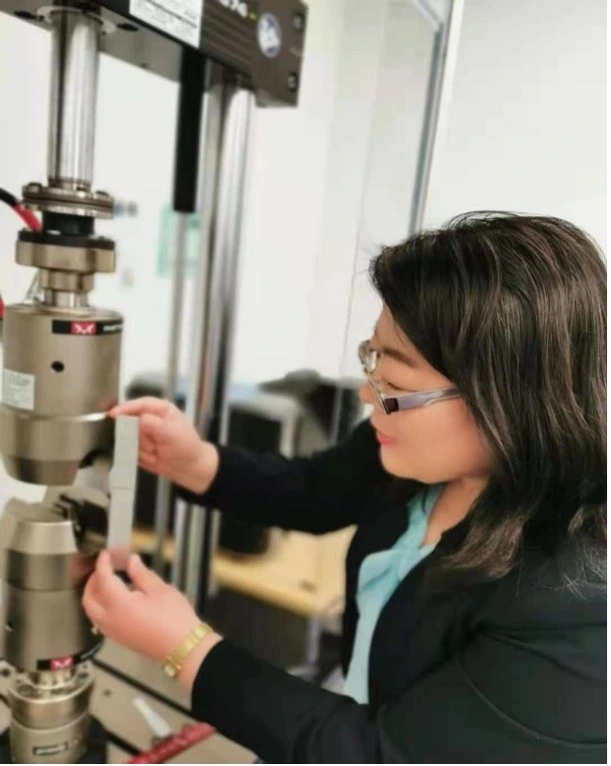Professor Sarah Zhang FTSE
Western Sydney University
Focus: Advanced Composite Materials and Manufacturing
Fellowship awarded: 2011
Importance to Australia: The impact I deliver comes from the application of fundamental and applied research to high-performance cementitious-based construction materials and composites across several industry sectors.
Research overview: My research focuses on high-performance composite materials and structures and the novel application of these materials in civil and mechanical/aeronautical structures. These include composite materials used in defence, mechanical/aerospace, and civil engineering applications. In addition, I am working on advanced manufacturing technology, including additive manufacturing. I am conducting this research with a view to improving sustainability and structural safety and resilience in multiple engineering areas.
What inspired you to pursue this area of research?
I am inspired by working on real world problems where I can deliver true impact.
My focus is on making a difference to industries and society, including the defence, civic and community sectors. I do this through innovations in science, engineering, technology; and through effective partnerships.
In civil engineering, I work on cement-based green construction materials. I do this by using industrial by-products and fibre reinforcement to achieve durable, resilient and sustainable infrastructures.
In mechanical/aeronautical engineering, I conduct studies on composite materials and structures, including nanocomposites. My research aims to improve the structural integrity and performance of components used across various industries, such as defence, aerospace, and mining.
How does your research address existing gaps and challenges in your specialist field?
My research tackles the challenges with the structural performance, durability and resilience of materials and structures across multiple applications. The problems come from real practice and industry and community needs. I address these complex problems by delivering solutions through science knowledge, and by developing new and novel knowledge and theory. I use an effective combination of fundamental and applied research to ensure my research advances novel methods and theory and, can deliver true impact to society.
The combination of my expertise in experimental studies and numerical modelling and analysis, means I can calibrate the mechanical behaviour of materials, and their structural behaviour through the effective application of both approaches. My research can go deep to discover the mechanisms behind the mechanical behaviour of materials.
How will your research contribute to Australian sovereign capabilities and defence innovation?
A key contribution of my research is the use of advanced composite material and structures in various defence platforms, including air, sea and land. I have developed close research collaborations with several defence research organisations and defence-related industries.
I have been awarded 15 defence-related projects including two Next Generation Technology Fund (NGTF) projects since 2018. This has led to significant defence innovation and has enhanced the research and defence capabilities in maintaining and safeguard vital defence infrastructure.
For example, I led a team and developed the high-performance nanocomposite adhesive materials for rapid patch repair, for which I was presented with the Inaugural 'Brilliant people, collaborative culture leadership award' by the Chief Defence Scientist from the Australian Government Department of Defence. I received my award at the 2022 Defence Science, Technology and Research Summit. This research was the finalist in the prestigious Australian Museum Eureka Prize for Department of Defence Outstanding Science in Safeguarding Australia category.
The high-performance nanocomposite adhesive has significant impacts on Australia's defence assets. This adhesive can improve the reliability and durability of structural joints and advance the manufacturing of composites. The ability to rapidly repair damaged aircraft is vital, and the nanocomposite is not only more adaptable than current options, but also stronger. This means our material could enhance defence platform resilience, reduce costs, and increase safety and readiness of defense infrastructures.
What does the Spitfire Memorial Defence Fellowship (SMDF) and the funding awarded to you mean to you and your research?
I was awarded the Spitfire Memorial Defence Fellowship in 2011. I used the Fellowship to support my research into fibre-reinforced cement-based composite for impact resistance.
I used the fund to employ a Research Associate to work on the project. This helped in developing my research records and excellence in defence-related research. This was also helpful in my grant applications and success for the major defence projects I worked on.
What else you would like to share about your work and its significance?
I was elected as Fellow of the Australian Academy of Technical Science and Engineering in 2024, which recognised my impactful research. Up to October 2024, I published 400+ research papers, including more than 210 in top international journals. These papers have significantly advanced knowledge in the research areas of cement-based construction materials, composite materials and structures, and numerical modelling and analysis.
I was awarded a total fund of A$15 million, including 3 ARC DP projects (2 as lead Chief Investigator), 1 ARC Linkage project, 3 projects in ARC training hub/centre, 2 ARC LIEF projects, and 2 Next Generation Defence Funds as lead Chief Investigator.
I have been working closely with 15 industries in recent years and have established close research collaborations during this period.
Articles and Links
Google scholar link to Professor Zhang's research


